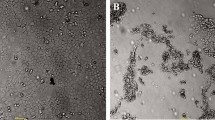Abstract
In view of the emergence of multidrug-resistant cancer cells, there is a need for therapeutic alternatives. Keeping this in mind, the present study was aimed at evaluating the synergism between nisin (an antimicrobial peptide) and doxorubicin (DOX) against DMBA-induced skin carcinogenesis. The possible tumoricidal activity of the combination was evaluated in terms of animal bioassay observations, changes in hisotological architecture of skin tissues, in situ apoptosis assay (TUNEL assay) and in terms of oxidant and antioxidant status of the skin tissues. In vivo additive effect of the combination was evidenced by larger decreases in mean tumour burden and tumour volume in mice treated with the combination than those treated with the drugs alone. Histological observations indicated that nisin-DOX therapy causes chromatin condensation and marginalisation of nuclear material in skin tissues of treated mice which correlated well with the results of TUNEL assay wherein a marked increase in the rate of apoptosis was revealed in tissues treated with the combination. A slightly increased oxidative stress in response to the adjunct therapy as compared to dox-alone-treated group was revealed by levels of lipid peroxidation (LPO) and nitrite generation in skin tissue-treated mice. An almost similar marginal enhancement in superoxide dismutase levels corresponding with a decrease in catalase activity could also be observed in nisin + DOX-treated groups as compared to nisin and dox-alone-treated groups. These results point towards the possible use of nisin as an adjunct to doxorubicin may help in developing alternate strategies to combat currently developing drug resistance in cancer cells.




Similar content being viewed by others
References
Kakde D, Jain D, Shrivastava V, Kakde R, Patil AT. Cancer therapeutics—opportunities, challenges and advances in drug delivery. J App Pharm Sci. 2011;1:1.
Aly A, Mullins CD, Hussain A. Understanding heterogeneity of treatment effect in prostate cancer. Curr Opin Oncol. 2015;27:209–16.
Busch CJ, Tribius S, Schafhausen P, Knecht R. The current role of systemic chemotherapy in the primary treatment of head and neck cancer. Cancer Treat Rev. 2015;41:217–21.
Coward JI, Middleton K, Murphy F. The new perspectives on targeted therapy in ovarian cancer. Int J Wom Health. 2015;7:189–03.
Hoskin DW, Ramamoorthy A. Studies on anticancer activities of antimicrobial peptides. Biochim Biophys Acta Biomembr. 2008;1778:357–75.
Schweizer F. Cationic amphiphilic peptides with cancer-selective toxicity. Eur J Pharm. 2009;625:190–4.
Bhutia SK, Maiti TK. Targeting tumours with peptides from natural sources. Trends Biotechnol. 2008;26:210–7.
Wei XQ, Ma HQ, Liu AH, Zhang YZ. Synergistic anticancer activity of 5-aminolevulinic acid photodynamic therapy in combination with low-dose cisplatin on Hela cells. Asian Pac J Cancer Prev. 2013;14:3023–8.
Sylvester PW, Wali VB, Bachawal SV, Shirode AB, Ayoub NM, Akl MR. Tocotrienol combination therapy results in synergistic anticancer response. Front Biosci (Landmark Ed). 2011;1:3183–95.
Jay JM. Modern Food Microbiology. 6th ed. Gaithersburg: Aspen Publishers Inc; 2000. p. 679.
Joo NE, Ritchie K, Kamarajan P, Miao D, Kapila YL. Nisin, an apoptogenic bacteriocin and food preservative, attenuates HNSCC tumourigenesis via CHAC1. Cancer Med. 2012;1:295–05.
Arora N, Koul A, Bansal MP. Chemopreventive activity of Azadirachta indica on two-stage skin carcinogenesis in murine model. Phytother Res. 2011;25:408–16.
Subapriya R, Nagini S. Medicinal properties of neem leaves: a review. Curr Med Chem Anti Cancer Agents. 2005;5:149–56.
Bharati S, Rishi P, Koul A. Azadirachta indica modulates electrical properties and type of cell death in NDEA-induced hepatic tumours. Cell Biochem Bioph. 2014;70:383–90.
Wills ED. Mechanisms of lipid peroxide formation in animal tissues. Biochem J. 1966;99:667–76.
Rishi P, Preet S, Bharrhan S, Verma I. In vitro and in vivo synergistic effects of cryptdin- 2 and ampicillin against Salmonella. Antimicrob Agents Chemother. 2011;55:4176–82.
Green LC et al. Analysis of nitrate, nitrite and 15N nitrate in biological fluids. Anal Biochem. 1982;126:131–8.
Luck H. Catalase. In: Bergmeyer HU, editor. Methods of enzymatic analysis. New York: Academic Press; 1963. p. 885–88.
Lowry OH, Rosenbrough NJ, Farr AL, Randell RJ. Protein measurement with Folin’s phenol reagent. J Biol Chem. 1951;193:265–75.
Diwan BA, Kasprzak KS, Anderson LM. Promotion of dimethylbenzanthracene-initiated mammary carcinogenesis by iron in female Sprague–Dawley rats. Carcinogenesis. 1997;18:1757–62.
Coussens LM, Tinkle CL, Hanahan D, Werb Z. MMP-9 supplied by bone marrow–derived cells contributes to skin carcinogenesis. Cell. 2000;103:481–90.
Padmavathi B, Upreti M, Singh V, Rao AR, Singh RP, Rath PC. Chemoprevention by Hippophae rhamnoides: effects on tumourigenesis, phase II and antioxidant enzymes, and IRF-1 transcription factor. Nutr Cancer. 2005;51(1):59–67.
Yokochi T, Robertson KD. Doxorubicin inhibits DNMT1 resulting in conditional apoptosis. Mol Pharmacol. 2004;66:1415–20.
Aldieri E, Bergandi L, Riganti C, Costamagna C, Bosia A, Ghigo D. Doxorubicin induces an increase of nitric oxide synthesis in rat cardiac cells that is inhibited by iron supplementation. Toxicol Appl Pharmacol. 2002;185:85–90.
Tamir S, Tannenbaum SR. The role of nitric oxide (NO) in the carcinogenic process. Biochim Biophys Acta. 1996;1288:F31–6.
Murphy MP. Nitric oxide and cell death. Biochim Biophys Acta. 1999;1411:401–14.
Bartoli GM, Galeotti T. Growth-related lipid peroxidation in tumour microsomal membranes and mitochondria. Biochimica et Biophysica Acta (BBA)—Lipids and Lipid. Metabolism. 1979;574:537–41.
Acknowledgments
The authors are grateful to Dr. B.N. Dutta for his support in histopthological analysis and Dr. S.N Sanyal for sharing his immense knowledge with us.
Authors’ contributions
Conceived and designed the study: SP. Performed lab analysis: SB and AP. Performed data analysis: SB. Wrote the manuscript: SP and PR. Provided lab facilities and helped in data analysis: SP, PR and RT.
Conflict of interest
The authors declare that there are no conflicts of interest.
Author information
Authors and Affiliations
Corresponding author
Rights and permissions
About this article
Cite this article
Preet, S., Bharati, S., Panjeta, A. et al. Effect of nisin and doxorubicin on DMBA-induced skin carcinogenesis—a possible adjunct therapy. Tumor Biol. 36, 8301–8308 (2015). https://doi.org/10.1007/s13277-015-3571-3
Received:
Accepted:
Published:
Issue Date:
DOI: https://doi.org/10.1007/s13277-015-3571-3




